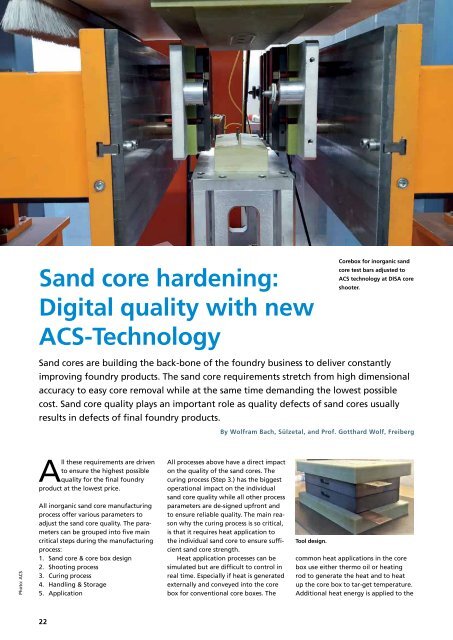You also want an ePaper? Increase the reach of your titles
YUMPU automatically turns print PDFs into web optimized ePapers that Google loves.
Sand core hardening:<br />
Digital quality with new<br />
ACS-Technology<br />
Corebox for inorganic sand<br />
core test bars adjusted to<br />
ACS technology at DISA core<br />
shooter.<br />
Sand cores are building the back-bone of the foundry business to deliver constantly<br />
improving foundry products. The sand core requirements stretch from high dimensional<br />
accuracy to easy core removal while at the same time demanding the lowest possible<br />
cost. Sand core quality plays an important role as quality defects of sand cores usually<br />
results in defects of final foundry products.<br />
By Wolfram Bach, Sülzetal, and Prof. Gotthard Wolf, Freiberg<br />
Photo: ACS<br />
All these requirements are driven<br />
to ensure the highest possible<br />
quality for the final foundry<br />
product at the lowest price.<br />
All inorganic sand core manufacturing<br />
process offer various parameters to<br />
adjust the sand core quality. The parameters<br />
can be grouped into five main<br />
critical steps during the manufacturing<br />
process:<br />
1. Sand core & core box design<br />
2. Shooting process<br />
3. Curing process<br />
4. Handling & Storage<br />
5. Application<br />
All processes above have a direct impact<br />
on the quality of the sand cores. The<br />
curing process (Step 3.) has the biggest<br />
operational impact on the individual<br />
sand core quality while all other process<br />
parameters are de-signed upfront and<br />
to ensure reliable quality. The main reason<br />
why the curing process is so critical,<br />
is that it requires heat application to<br />
the individual sand core to ensure sufficient<br />
sand core strength.<br />
Heat application processes can be<br />
simulated but are difficult to control in<br />
real time. Especially if heat is generated<br />
externally and conveyed into the core<br />
box for conventional core boxes. The<br />
Tool design.<br />
common heat applications in the core<br />
box use either thermo oil or heating<br />
rod to generate the heat and to heat<br />
up the core box to tar-get temperature.<br />
Additional heat energy is applied to the<br />
22

















